Abstract
Fluorescent chemosensors are powerful imaging tools used in a broad range of biomedical fields. However, the application of fluorescent dyes in bioimaging still remains challenging, with small Stokes shifts, interfering signals, background noise, and self-quenching on current microscope configurations. In this work, we reported a supramolecular cage (CA) by coordination-driven self-assembly of benzothiadiazole derivatives and Eu(OTf)3. The CA exhibited high fluorescence with a quantum yield (QY) of 38.57%, good photoluminescence (PL) stability, and a large Stokes shift (153 nm). Furthermore, the CCK-8 assay against U87 glioblastoma cells verified the low cytotoxicity of CA. We revealed that the designed probes could be used as U87 cells targeting bioimaging.
1. Introduction
Self-assembly allows for the efficient construction of supramolecular structures from relatively simple components. As a class of such architectures, metal-organic cages (MOCs) have gained significant attention in recent years [1,2,3,4]. Numerous MOCs exhibit astonishing multifunctional capabilities that have been created by regulating and controlling the coordination environment surrounding the core metal ions, as well as the suitable choice of organic ligands. Consequently, they have found applications in areas such as catalysis [5,6,7,8,9,10], molecular recognition [11,12,13,14,15,16,17], biological imitation [18,19,20,21,22], guest sequestration [23,24,25], reactive species stabilization [26], drug delivery [27,28,29], and membrane transportation [30,31], among others.
The diagnosis and treatment of disease require better and faster pathological analysis, as well as highly contrasting real-time biological images. Optical emission probes combined with disease diagnosis and treatment are becoming strong candidates, owing to their only slight disturbance of the systems and organs being researched. When the appropriate wavelength is used, the penetration depth of optical emission probes can be substantial, and then the light can reach regions of complex molecular structures that are inaccessible to other molecular probes. As a consequence, building supramolecular structures, which have strong fluorescence to achieve deeper tissue penetration for imaging or cell tracking studies to monitor biological processes, has recently attracted increasing attention [32,33]. Significantly, lanthanide ions with special optical and magnetic properties serve as functional centers on which to build the supramolecular structures, and which have found uses across various fields [34,35], such as luminous probes [36,37,38,39], analyte sensing [40,41], and tissue [42,43]. Furthermore, the pharmaceutical properties of lanthanide (III) ionic have also been demonstrated as antibacterial agents (anticancer, anticoagulant, anti-inflammatory, etc.), and play a crucial role in medicine, especially cancer diagnosis and treatment [44]. However, the difficulty of predicting the coordination numbers of lanthanides and coordination geometry makes the controlled self-assembly of predetermined structures quite challenging. Most studies have been limited to small systems, such as single-core beams or two-core helixes; the design and the application of three-dimensional lanthanide components have not been thoroughly studied.
In this context, we report the synthesis of three-dimensional (3D) dimetallic lanthanide complexes with saturated coordination spheres. Two-armed tri-toothed benzothiadiazole derivatives acted as organic ligands and coordination-driven self-assembly with Eu(OTf)3 in a ratio of 2:3 to form a single structure. Trivalent lanthanides display a tendency to adopt nine-coordinate tricapped trigonal prismatic (TTP) arrangements around the metal ion in the solid state, and the 3D molecular buildings are capable of great fluorescence. Well-defined solid clusters enable this supramolecular cage structure to efficiently target the staining of living cancer cells with low biotoxicity (Figure 1).
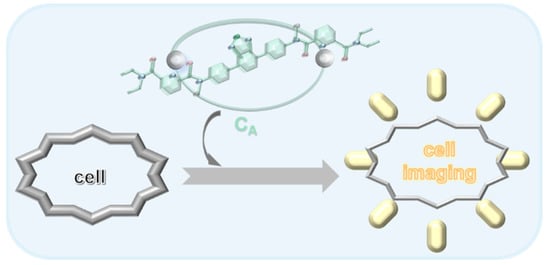
Figure 1.
The preparation and characterization of CA.
2. Results and Discussion
2.1. The Preparation and Characterization of CA
Highly predisposed O-N-O tridentate chelators with amide groups were introduced into linear shape molecules N2,N2’-(benzo[c][1,2,5]thiadiazole-4,7-diylbis(4,1-phenylene))bis(N6,N6-diethylpyridine-2, 6-dicarboxamide) (L-B), to control the coordination of lanthanide ions and obtain highly ordered architectures [45,46,47]. The L-B was synthesized by amide condensation of freshly prepared 6-(diethylcarbamoyl)picolinic acid with 4, 4’-(benzo[c][1,2,5]thiadiazole-4, 7-diyl)dianiline. The formation of the supramolecular cage was quantitatively carried out, L-B (3 equiv.) and Eu(OTf)3 (2 equiv.) were dissolved in 600 μL CH3CN/CH3OH (v/v, 1/1), respectively, and stirred in a 10 mL flask at room temperature for 5 h. After the reaction, 5 mL diethyl ether was added and centrifuged to obtain CA as an orange-red solid (Scheme 1 and Figures S1–S9).
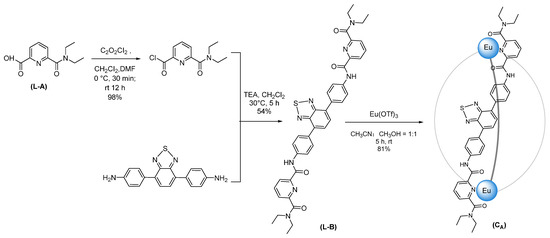
Scheme 1.
Synthesis of ligand (L-B) and self-assembly of metal-organic cage (CA).
Multinuclear NMR (1H, DOSY, COSY, and NOSEY) analysis (Figure 2 and Figures S10–S14), IR spectrum, and electrospray ionization time-of-flight mass spectrometry (ESI-TOF-MS) confirmed the formation of CA. The 1H NMR spectrum of CA displayed only one set of ligand signals (Figure 2c), showing the formation of faces and vertices with a single stereochemical orientation. The shift in NMR signal could be observed after the formation of the supramolecular cage. As evidenced by the results, upfield chemical shifts were observed for the β-pyridyl protons He (from 8.066 to 7.146 ppm) and Hg (from 7.74 to 6.61 ppm) and γ-pyridyl protons Hf (from 8.324 to 7.629 ppm). Chemical displacement changes could also be observed in amide hydrogen Hd (from 10.052 to 7.225 ppm). Moreover, aromatic protons Ha, Hb, and Hc, belonging to 4,4’-(benzo[c][1,2,5]thiadiazole-4,7-diyl)dianiline, shifted upfield as well (Figure 2b,c). All of these chemical shift changes pointed to the formation of CA. 2D DOSY NMR also revealed the formation of a single species in solution, with a diffusion coefficient of 4.79 × 10−10 m2/s. The infrared spectrum also confirmed the successful coordination-driven self-assembly of CA (Figures S15 and S16). According to the results, the characteristic peaks of C=O (from 1686 to 1601 cm−1) and N-H (from 1625 to 1575 cm−1) were significantly changed.
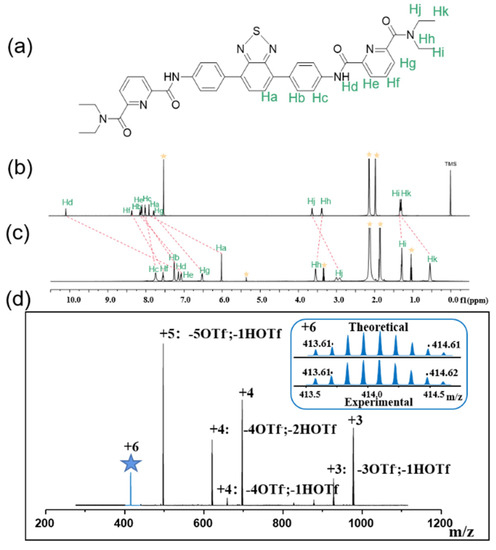
Figure 2.
(a) The structure of L-B. (b) 1H NMR spectra (600 MHz, CD3CN/CDCl3 = 1:1), 298 K) of L-B (the solubility of L-B in CD3CN was poor, and CDCl3 was added to help dissolve). (c) 1H NMR spectra (600 MHz, CD3CN, 298 K) of CA [the yellow five-pointed star label indicates the solvent peak]. (d) ESI-MS spectra of CA and showing the observed z = +6 charge for the peak at m/z = 414.11 (bottom) compared to the theoretical isotopic pattern (top).
Additionally, electrospray ionization-mass spectrometry (ESI-MS) indicated the successful assembly of CA, and the detected ESI-MS data of the resultant cage was nearly identical to the theoretical data. The spectra showed a series of peaks with charge states ranging from 3+ to 6+, resulting from the sequential loss of OTf- counterions or HOTf molecules. For example, peaks with m/z = 414.11 correspond to [Eu2L3(OTf)6-6OTf-]6+ charged species. (Figure 2d). The most abundant peak at m/z = 496.84 exhibited typical m/z splitting for a 5+ charged species and was assigned to [Eu2L3(OTf)6-6OTf--HOTf]5+. The average molar mass of the self-assembled cage CA after deconvolution was 3378 Da, which was in good agreement with their predicted chemical compositions [C126H114N24O30F18S9Eu2] and ruled out the formation of any subsequent undesirable complexes (Figures S17–S19).
The complete data for single crystal X-ray analysis could not be obtained despite numerous attempts. Consequently, we developed a computerized molecular model of the CA (Figure 3a,b). Two europium ions were nine-coordinated by tridentate O-N-O chelating moieties from three distinct ligands in the energy-minimized structure. The metal-metal distance between europium ion centers in the energy-minimized structure was 19.17 Å (as measured by Materials Studio.) Contrary to L-B, CA had a geometry-optimized structure that revealed one of the ligands to be severely twisted out of the ligand plane, which prevented a cavity from forming in the supramolecular cage. Scanning electron microscopy (SEM) revealed that CA was in a good state of aggregation, and showed a uniform spherical morphology (Figure 3c). This matched the molecular structure that we modeled.
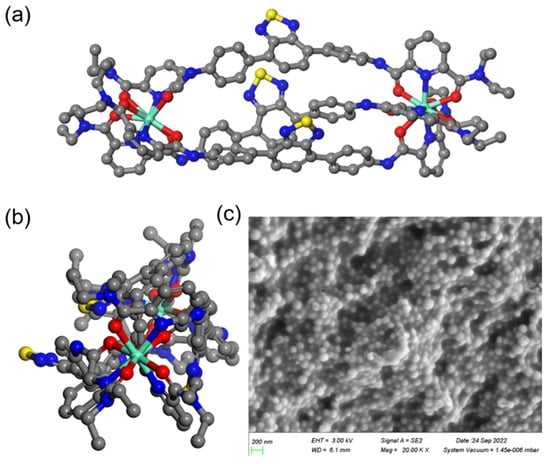
Figure 3.
Energy-minimized molecular model of CA (Eu, green; N: blue; S, yellow; O, red; C, gray). Hydrogens, counteranions are omitted for clarity; (a) side view and (b) top view. (c) TEM images of CA.
2.2. Optical Properties
The enormous Stokes shift and the outstanding PL QY are the distinguishing characteristics of CA. Figure 4 shows the optical properties of CA in acetonitrile. The UV-Vis absorption spectra (Figure S20) showed that the CA possessed continuous absorption from the UV region to about 475 nm. The absorption bands at 210–250 nm could be ascribed to π-π* transition from aromatic C=C bonds; a peak at 275–340 nm was also observed, which may be attributed to the n-π* transition of C=O on the surface of CA. Absorbance significantly increased compared with L-B, and an M-shaped peak appeared, which was attributed to the interaction between C=O bonds and Eu (III) ions within the process of self-assembly. The absorption peak located at 375–450 nm was assigned to the C=N absorption of pyridine-N in the carbon core and the polycyclic aromatic units. The excitation spectrum of CA showed the best excitation wavelength of 400 nm, and the PL emission peak was centered at 553 nm (Figure 4a). Due to the CA having a large Stokes shift reaching 153 nm, the small self-absorption of CA could be expected, which enabled efficient PL emission. Under the optimum excitation wavelength, the absolute PL quantum yield of CA was 38.57% (Figure S21). As illustrated, the decay profiles fit single exponential functions, giving lifetimes of 7.93 ns for CA (Figure 4b). The emission spectrum of CA with different concentrations demonstrated that the change of concentration did not affect maximum emission (Figure 4c). Additionally, we explored CA’s PL stability (Figure 4d) under the influence of a 400 nm blue light for 400 s; the PL intensity of the CA solution remained constant. Therefore, the supramolecular cage structure showed surprising advantages in terms of a significant Stokes shift, an extremely high PL QY, and good fluorescence stability, all of which are advantageous for applications.
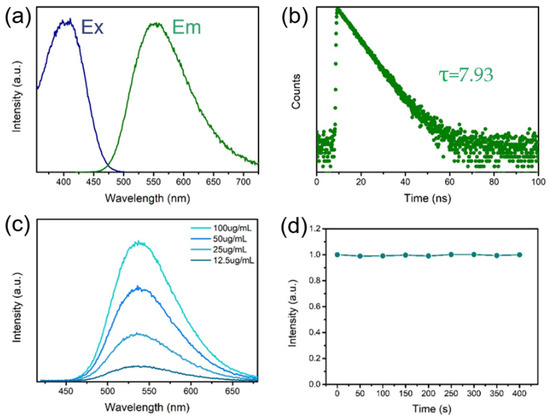
Figure 4.
Optical properties of CA in acetonitrile. (a) PLE and PL emission spectra of CA (c = 50 μg/mL). (b) Time-resolved decay spectra of CA (c = 50 μg/mL). The data were collected at an emission peak of 553 nm (λex = 400 nm). (c) Variable concentration PL spectra of CA. (d) PL photostability tests of CA (c = 50 μg/mL, λex = 400 nm λem = 537 nm). The samples were treated with the irradiation of a 400 nm blue light.
2.3. In Vitro Cytotoxicity Profiles and CLSM Images
After the addition of DMEM medium, it was found that the characteristic peaks of CA did not change (Figure S22). Therefore, the structure of CA remained stable during the process of biological experiments. The cytotoxic activity of the CA against U87 cells was evaluated. Cultured cancer cells were treated with concentrations of 0, 12.5, 25, 50, and 100 μg/mL of CA in basal medium. The percentage of cell viability was determined by Cell Counting Kit-8 (CCK-8) assay. In the U87 cytotoxicity assay, the CA presented 84.95, 82.97, 87.27, and 77.43% cell viability at increasing concentrations (Figure 5a), and the results showed good biosafety. Then, we used confocal laser scanning microscopy to evaluate the suitability of low-toxicity CA (25 μg/mL, and 50 μg/mL) for bioimaging. An intracellular fluorescence signal from CA was clearly observed (Figure 5b), the fluorescence intensity gradually increased in line with the increase in concentration of CA, while no emission was found in the control group. Therefore, CA with 50 μg/mL concentration was selected for cell imaging to achieve accurate labeling of U87 glioblastoma cells.
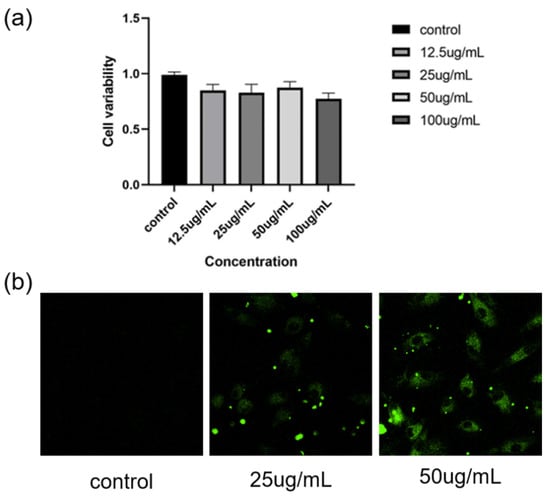
Figure 5.
(a) In vitro U87 cytotoxicity profiles of CA. Mean values and error bars were defined as mean and s.d., respectively. Experiments were performed in triplicate. (b) CLSM images of viable cell distributions after co-incubation with CA at varied concentrations: 0, 25, and 50 μg/mL for 4 h.
3. Materials and Methods
3.1. Materials
All reagents were purchased from Sigma-Aldrich, Shanghai, China, Fisher, Shanghai, China, Acros, Shanghai, China, Bide Pharmatech Ltd., Shanghai, China, and, Alfa Aesar, Tianjin, China, and were used without further purification. All solvents were dried according to standard procedures and all of them were degassed under N2 for 30 min before use.
3.2. Measurements
1H NMR and 13C NMR spectra were measured on a Bruker AV 600 spectrometer. ESI-MS was recorded with a Waters Synapt G2-Si mass spectrometer, USA, in ESI mode. The UV–Vis spectra were recorded on a dual-beam UV–Vis spectrophotometer (TU-1901), PERSEE, Beijing, China. Fluorescent spectra were collected on a HORIBA FluoroLog-3 fluorescence spectrometer and Horiba-FluoroMax-4 spectrofluorometer, HORIBA, Edison, NJ, USA. The luminescence lifetimes were measured on an Edinburgh FLS 980 fluorescence spectrometer, Edinburgh Instruments, UK. The photoluminescence quantum yield (PLQY) was measured using an integrating sphere on a HORIBA FluoroLog-3 fluorescence spectrometer, HORIBA, Edison, NJ, USA. The Fourier Transform Infrared FT-IR spectra were recorded on a Spectrum TWO FT-IR spectrophotometer, PerkinElmer, Llantrisant, UK.
3.3. Materials Synthesis
3.3.1. Preparation of 2-Ethoxycarbonyl-carboxypyridine
Dipicolinic acid (5.00 g, 32.9 mmol) was refluxed for 4 h in methanol: water mixture (50 mL/50 mL) containing concentrated H2SO4 (5 mL). The cooled solution was poured onto saturated NaHCO3 (500 mL) and the aq. phase was extracted with dichloromethane (4 × 100 mL). Acidification of the resulting aq. phase (pH = 2) with concentrated hydrochloric acid (pH = 2) followed by extraction with dichloromethane (4 × 100 mL) provided a second organic phase, which was dried (anhydrous Na2SO4) and evaporated to dryness to afford 2-ethoxycarbonyl-carboxypyridine (3.51 g, 59% 19.4 mmol) as a white powder. 1H NMR (600 MHz, CD3OD) δ 8.33 (dd, J = 18.5, 7.5 Hz, 2H), 8.17 (t, J = 7.8 Hz, 1H), 4.02 (s, 3H). 13C NMR (151 MHz, CDCl3) δ 164.2, 163.5, 146.8, 146.5, 139.6, 128.8, 126.9, 53.2.
3.3.2. Preparation of L-A
Oxalyl chloride (1.68 g, 13.25 mmol) and 2-ethoxycarbonyl-carboxypyridine (2.00 g, 11.04 mmol) were dissolved in DMF (0.1 mL) and dry dichloromethane (100 mL) at 0 °C for 30 min; the whole reaction mixture was stirred at room temperature for 12 h. The resulting mixture was evaporated to dryness, and dissolved in dry dichloromethane (50 mL), then, N, N-diethylamine (17.10 mL, 16.50 mmol), and stoichiometric excess Et3N were added dropwise at room temperature and the solution was stirred for 5 h. The solution was washed with portions of 1 N HCl, followed by 1 N NaOH, and, finally, water. The organic layer was isolated, dried over MgSO4, and concentrated by rotary evaporation. Diethyl ether was added to precipitate the product as white precipitates, which were collected by filtration and dried. The compound obtained above was then dissolved into a solution of 1 N KOH and stirred for 1 h at room temperature. After washing with dichloromethane (2 × 50 mL), the aq. phase was neutralized (pH = 2) with concentrated hydrochloric acid and kept at 4 °C for 12 h. The mixture was extracted with dichloromethane (3 × 50 mL), dried over anhydrous Na2SO4, filtered, and then concentrated under reduced pressure to afford 6-(N,N-diethylcarbamoyl)pyridine-2-carboxylic acid (L-A, 1.69 g, 69% 7.62 mmol) as a white powder. 1H NMR (600 MHz, CD3OD) δ 8.21 (d, J = 7.8 Hz, 1H), 8.10 (t, J = 7.8 Hz, 1H), 7.76 (d, J = 7.7 Hz, 1H), 3.58 (q, J = 7.1 Hz, 2H), 3.33 (q, J = 7.1 Hz, 2H), 1.28 (t, J = 7.1 Hz, 3H), 1.19 (t, J = 7.1 Hz, 3H). 13C NMR (151 MHz, CDCl3) δ 166.8, 163.6, 154.0, 145.0, 140.0, 127.2, 124.4, 43.2, 40.3, 14.5, 12.8.
3.3.3. Preparation of L-B
L-A (111.05 mg, 0.50 mmol) and Oxalyl chloride (76.15 mg, 0.60 mmol) were dissolved in DMF (0.1 mL) and dry dichloromethane (30 mL) at 0 °C for 30 min; the whole reaction mixture was stirred at room temperature for 12 h, and then concentrated by rotary evaporation. Then, 4,4’-(benzo[1,2,5]thiadiazole-4,7-diyl)dianiline (53.10 mg, 0.17 mmol) was added dropwise at room temperature and the solution was stirred for 5 h. The solution was washed with portions of 1 N HCl, followed by 1 N NaOH and, finally, saturated sodium chloride solution. The organic layer was isolated, dried over MgSO4, and concentrated to 5 mL by rotary evaporation. The mixture was poured into diethyl ether (50 mL) to give a precipitate, which was collected by centrifugation to afford L-B (65.40 mg, 54% 0.09 mmol) as a yellow powder. 1H NMR (600 MHz, CDCl3/CD3CN = 1:1) δ 10.05 (s, 1H), 8.33 (d, J = 7.6 Hz, 1H), 8.11 (t, J = 7.7 Hz, 1H), 8.07 (d, J = 8.6 Hz, 2H), 7.98 (d, J = 8.6 Hz, 2H), 7.88 (s, 1H), 7.76 (d, J = 7.7 Hz, 1H), 3.62 (q, J = 7.0 Hz, 3H), 3.37 (q, J = 6.9 Hz, 2H), 1.48–1.12 (m, 7H). 13C NMR (151 MHz, CDCl3) δ 167.6, 161.5, 154.1, 153.7, 148.5, 138.9, 137.7, 133.6, 132.5, 130.0, 127.8, 126.0, 123.1, 119.8, 43.2, 40.2, 14.7, 12.8.
3.3.4. Preparation of CA
L-B (13.10 mg, 0.018 mmol) and Eu(OTf)3 (7.19 mg, 0.012 mmol) were added to a solution of methanol: acetonitrile mixture (600 μL/600 μL); the solution was stirred at room temperature for 5 h. The reaction mixture was poured into diethyl ether (10 mL) to give a precipitate, which was collected by centrifugation to afford CA (16.40 mg, 81% 0.0048 mmol) as an orange-red solid. 1H NMR (600 MHz, CD3CN) δ 7.86 (s, 2H), 7.66 (t, J = 7.7 Hz, 1H), 7.37 (d, J = 6.6 Hz, 2H), 7.26 (s, 1H), 7.18 (d, J = 7.7 Hz, 1H), 6.64 (d, J = 7.9 Hz, 1H), 6.13 (s, 1H), 3.66 (d, J = 6.7 Hz, 2H), 3.07 (d, J = 51.0 Hz, 2H), 1.40 (t, J = 6.7 Hz, 3H), 0.66 (s, 3H).
3.4. Fluorescence Lifetime
The fluorescence lifetime is measured by the single exponential fitting method; the formula is as follows:
3.5. Fluorescence Quantum Yield
The absolute fluorescence quantum yield is measured using the four-curve method; the formula is as follows:
Ea is sample emission area, Ec is blank emission area, La is sample excitation area, Lc is blank excitation area. (Scatter Range: 395.00 to 415.00 nm. Emission Range: 465.00 to 749.00 nm).
3.6. Cell Variability Assay
U87 glioblastoma cells were purchased from Stem Cell Bank, Chinese Academy of Sciences. The cell line was authenticated and tested free of mycoplasma. The U87 cells were grown in DMEM containing 10% fetal bovine serum and 1% penicillin-streptomycin. The cells were maintained at 37 °C in a humidified atmosphere with 5% CO2. For this, 5000 cells in 100 µL per well were seeded in a 96-well plate and incubated for 24 h, then the cells were treated with different concentrations of CA in basal medium, in triplicate. Following 24-h incubation, the cells were incubated with 10% CCK-8 containing DMEM high-glucose medium at 100 µL per well at 37 °C in a humidified atmosphere with 5% CO2. CCK-8 could selectively stain the viable cells in 1 h, read by a spectrometer at 450 nm.
3.7. Live Cell Imaging
U87 cancer cells were plated on 35 mm plates (1 × 105 cells in 1 mL media per plate) and maintained at 37 °C in a humidified atmosphere with 5% CO2 for 24 h. Subsequently, the medium was discarded and the disks were rinsed with PBS twice, before 1 mL of DMEM high-glucose containing 25 μg/mL and 50 μg/mL of CA were replaced. Following 4-h incubation, forming fluorescent of CA (λex = 405 nm, λem = 546 nm) could be observed by confocal laser scanning microscopy (LSM 980 ZEISS).
4. Conclusions
In conclusion, we designed and synthesized a coordination-driven self-assembly supramolecular for cell imaging of live U87 glioblastoma cells. This supramolecular cage structure showed surprising advantages in terms of its unique low biotoxicity, high targeting, a large Stokes shift, high fluorescence efficiency, and strong photostability. This study will provide some guidance for the design of abundant organelle targeting probes and provide new ideas for further cancer diagnosis and treatment.
Supplementary Materials
The supporting information can be downloaded at: https://www.mdpi.com/article/10.3390/ijms24032147/s1.
Author Contributions
Conceptualization, L.S. and X.-Q.H.; methodology, D.A. and T.L.; validation, Y.C. and T.L.; formal analysis, D.A., H.-Y.Z. and L.S.; investigation, D.A.; writing—original draft preparation, L.S. and D.A.; writing—review and editing, L.S.; supervision, L.S. and X.-Q.H.; project administration, D.A.; funding acquisition, L.S. and M.-P.S. All authors have read and agreed to the published version of the manuscript.
Funding
This research was funded by the National Natural Science Foundation of China (Nos. 22101267, 21803059, U1904212, and U2004191), the Natural Science Foundation of Henan Province (No. 202300410477) and China Postdoctoral Science Foundation (No. 2021M692905).
Institutional Review Board Statement
Not applicable.
Informed Consent Statement
Not applicable.
Data Availability Statement
Not applicable.
Conflicts of Interest
The authors declare no conflict of interest.
References
- Cook, T.R.; Stang, P.J. Recent Developments in the Preparation and Chemistry of Metallacycles and Metallacages via Coordination. Chem. Rev. 2015, 115, 7001–7045. [Google Scholar] [CrossRef] [PubMed]
- Whitesides, M.G.; Grzybowsk, B. Self-Assembly at All Scales. Science 2002, 295, 2418–2421. [Google Scholar] [CrossRef] [PubMed]
- Leininger, S.; Olenyuk, B.; Stang, P.J. Self-Assembly of Discrete Cyclic Nanostructures Mediated by Transition Metals. Chem. Rev. 2000, 100, 853–908. [Google Scholar] [CrossRef] [PubMed]
- Chakrabarty, R.; Mukherjee, P.S.; Stang, P.J. Supramolecular Coordination: Self-Assembly of Finite Two- and Three-Dimensional Ensembles. Chem. Rev. 2011, 111, 6810–6918. [Google Scholar] [CrossRef]
- Cakmak, Y.; Erbas-Cakmak, S.; Leigh, D.A. Asymmetric Catalysis with a Mechanically Point-Chiral Rotaxane. J. Am. Chem. Soc. 2016, 138, 1749–1751. [Google Scholar] [CrossRef]
- Cullen, W.; Takezawa, H.; Fujita, M. Demethylenation of Cyclopropanes via Photoinduced Guest-to-Host Electron Transfer in an M6L4 Cage. Angew. Chem. Int. Ed. 2019, 131, 9269–9271. [Google Scholar] [CrossRef]
- Cullen, W.; Misuraca, M.C.; Hunter, C.A.; Williams, N.H.; Ward, M.D. Highly Efficient Catalysis of the Kemp Elimination in the Cavity of a Cubic Coordination Cage. Nat. Chem. 2016, 8, 231–236. [Google Scholar] [CrossRef]
- Zhang, L.; Wei, Z.; Thanneeru, S.; Meng, M.; Kruzyk, M.; Ung, G.; Liu, B.; He, J. A Polymer Solution To Prevent Nanoclustering and Improve the Selectivity of Metal Nanoparticles for Electrocatalytic CO2 Reduction. Angew. Chem. Int. Ed. 2019, 131, 15981–15987. [Google Scholar] [CrossRef]
- Oldacre, A.N.; Friedman, A.E.; Cook, T.R. A Self-Assembled Cofacial Cobalt Porphyrin Prism for Oxygen Reduction Catalysis. J. Am. Chem. Soc. 2017, 139, 1424–1427. [Google Scholar] [CrossRef]
- Holloway, L.R.; Bogie, P.M.; Lyon, Y.; Ngai, C.; Miller, T.F.; Julian, R.R.; Hooley, R.J. Tandem Reactivity of a Self-Assembled Cage Catalyst with Endohedral Acid Groups. J. Am. Chem. Soc. 2018, 140, 8078–8081. [Google Scholar] [CrossRef]
- Lei, Y.; Chen, Q.; Liu, P.; Wang, L.; Wang, H.; Li, B.; Lu, X.; Chen, Z.; Pan, Y.; Huang, F.; et al. Molecular Cages Self-Assembled by Imine Condensation in Water. Angew. Chem. Int. Ed. 2021, 133, 4755–4761. [Google Scholar] [CrossRef]
- Burke, M.J.; Nichol, G.S.; Lusby, P.J. Orthogonal Selection and Fixing of Coordination Self-Assembly Pathways for Robust Metallo-organic Ensemble Construction. J. Am. Chem. Soc. 2016, 138, 9308–9315. [Google Scholar] [CrossRef] [PubMed]
- Jansze, S.M.; Cecot, G.; Severin, K. Reversible Disassembly of Metallasupramolecular Structures Mediated by A Metastable-state Photoacid. Chem. Sci. 2018, 9, 4253–4257. [Google Scholar] [CrossRef] [PubMed]
- Oldknow, S.; Martir, D.R.; Pritchard, V.E.; Blitz, M.A.C.; Zysman-Colman, E.; Hardie, M.J. Structure-switching M3L2 Ir(iii) Coordination Cages with Photo-isomerising Azo-aromatic Linkers. Chem. Sci. 2018, 9, 8150–8159. [Google Scholar] [CrossRef] [PubMed]
- Samanta, D.; Mukherjee, P.S. Sunlight-Induced Covalent Marriage of Two Triply Interlocked Pd6 Cages and Their Facile Thermal Separation. J. Am. Chem. Soc. 2014, 136, 17006–17009. [Google Scholar] [CrossRef]
- Kurihara, K.; Yazaki, K.; Akita, M.; Yoshizawa, M. A Switchable Open/closed Polyaromatic Macrocycle that Shows Reversible Binding of Long Hydrophilic Molecules. Angew. Chem. Int. Ed. 2017, 129, 11518–11522. [Google Scholar] [CrossRef]
- Regeni, I.; Chen, B.; Frank, M.; Baksi, A.; Holstein, J.J.; Clever, G.H. Teerfarben-basierte Koordinationskäfige und-helikate. Angew. Chem. Int. Ed. 2021, 133, 5736–5741. [Google Scholar] [CrossRef]
- Yang, G.; Zheng, W.; Tao, G.; Wu, L.; Zhou, Q.-F.; Kochovski, Z.; Ji, T.; Chen, H.; Li, X.; Lu, Y.; et al. Diversiform and Transformable Glyco-Nanostructures Constructed from Amphiphilic Supramolecular Metallocarbohydrates through Hierarchical Self-Assembly: The Balance between Metallacycles and Saccharides. ACS Nano 2019, 13, 13474–13485. [Google Scholar] [CrossRef]
- Wiester, M.J.; Ulmann, P.A.; Mirkin, C.A. Enzymnachbildungen Auf Der Basis Supramolekularer Koordinationschemie. Angew. Chem. Int. Ed. 2011, 123, 118–142. [Google Scholar] [CrossRef]
- Clever, P.G.H. Imidazole-modified G-quadruplex DNA as Metal-triggered Peroxidase. Chem. Sci. 2019, 10, 2513–2518. [Google Scholar] [CrossRef]
- Zamora-Olivares, D.; Kaoud, T.S.; Dalby, K.N.; Anslyn, E.V. In-Situ Generation of Differential Sensors that Fingerprint Kinases and the Cellular Response to Their Expression. J. Am. Chem. Soc. 2013, 135, 14814–14820. [Google Scholar] [CrossRef] [PubMed]
- Ulrich, S.; Dumy, P. Probing Secondary Interactions in Biomolecular Recognition by Dynamic Combinatorial Chemistry. Chem. Commun. 2014, 50, 5810. [Google Scholar] [CrossRef] [PubMed]
- Howlader, P.; Mondal, S.; Ahmed, S.; Mukherjee, P.S. Guest-Induced Enantioselective Self-Assembly of a Pd6 Homochiral Octahedral Cage with a C3-Symmetric Pyridyl Donor. J. Am. Chem. Soc. 2020, 142, 20968–20972. [Google Scholar] [CrossRef] [PubMed]
- Wu, K.; Zhang, B.; Drechsler, C.; Holstein, J.J.; Clever, G.H. Rückgrat-verknüpfte Liganden Erhöhen Die Vielfalt in Heteroleptischen Koordinationskäfigen. Angew. Chem. Int. Ed. 2021, 133, 6473–6478. [Google Scholar] [CrossRef]
- García-Simón, C.; Garcia-Borràs, M.; Gómez, L.; Parella, T.; Osuna, S.; Juanhuix, J.; Imaz, I.; Maspoch, D.; Costas, M.; Ribas, X. Sponge-like Molecular Cage for Purification of Fullerenes. Nat. Commun. 2014, 5, 5557. [Google Scholar] [CrossRef]
- Sawada, T.; Fujita, M. A Single Watson-Crick G·C Base Pair in Water: Aqueous Hydrogen Bonds in Hydrophobic Cavities. J. Am. Chem. Soc. 2010, 132, 7194–7201. [Google Scholar] [CrossRef]
- Samanta, S.K.; Quigley, J.; Vinciguerra, B.; Briken, V.; Isaacs, L. Cucurbit[7]uril Enables Multi-Stimuli-Responsive Release from the Self-Assembled Hydrophobic Phase of a Metal Organic Polyhedron. J. Am. Chem. Soc. 2017, 139, 9066–9074. [Google Scholar] [CrossRef]
- Zheng, Y.-R.; Suntharalingam, K.; Johnstone, T.C.; Lippard, S.J. Encapsulation of Pt(iv) Prodrugs within a Pt(ii) Cage for Drug Delivery. Chem. Sci. 2015, 6, 1189–1193. [Google Scholar] [CrossRef]
- Samanta, S.K.; Moncelet, D.; Briken, V.; Isaacs, L. Metal-Organic Polyhedron Capped with Cucurbit[8]uril Delivers Doxorubicin to Cancer Cells. J. Am. Chem. Soc. 2016, 138, 14488–14496. [Google Scholar] [CrossRef]
- Haynes, C.J.E.; Zhu, J.; Chimerel, C.; Hernández-Ainsa, S.; Riddell, I.A.; Ronson, T.K.; Keyser, U.F.; Nitschke, J.R. Blockable Zn10L15 Ion Channels through Subcomponent Self-Assembly. Angew. Chem. Int. Ed. 2017, 129, 15590–15594. [Google Scholar] [CrossRef]
- Kawano, R.; Horike, N.; Hijikata, Y.; Kondo, M.; Carné-Sánchez, A.; Larpent, P.; Ikemura, S.; Osaki, T.; Kamiya, K.; Kitagawa, S.; et al. Metal-Organic Cuboctahedra for Synthetic Ion Channels with Multiple Conductance States. Chem 2017, 2, 393–403. [Google Scholar] [CrossRef]
- Zhou, J.; Li, J.; Du, X.; Xu, B. Supramolecular Biofunctional Materials. Biomaterials 2017, 129, 1–27. [Google Scholar] [CrossRef] [PubMed]
- Xie, B.; Ding, Y.-F.; Shui, M.; Yue, L.; Gao, C.; Wyman, I.W.; Wang, R. Supramolecular Biomaterials for Bio-imaging and Imaging-guided Therapy. Eur. J. Nucl. Med. Mol. Imaging 2022, 49, 1200–1210. [Google Scholar] [CrossRef] [PubMed]
- Bünzli, J.-C.G.; Piguet, C. Lanthanide-Containing Molecular and Supramolecular Polymetallic Functional Assemblies. Chem. Rev. 2002, 102, 1897–1928. [Google Scholar] [CrossRef]
- Barry, D.E.; Caffrey, D.F.; Gunnlaugsson, T. Lanthanide-directed Synthesis of Luminescent Self-assembly Supramolecular Structures and Mechanically Bonded Systems from Acyclic Coordinating Organic Ligands. Chem. Soc. Rev. 2016, 45, 3244–3274. [Google Scholar] [CrossRef]
- Yeung, C.-T.; Yim, K.-H.; Wong, H.-Y.; Pal, R.; Lo, W.-S.; Yan, S.-C.; Yee-Man Wong, M.; Yufit, D.; Smiles, D.E.; McCormick, L.J.; et al. Chiral transcription in Self-assembled Tetrahedral Eu4L6 Chiral Cages Displaying Sizable Circularly Polarized Luminescence. Nat. Commun. 2017, 8, 1128. [Google Scholar] [CrossRef]
- Albrecht, M.; Osetska, O.; Fröhlich, R.; Bünzli, J.-C.G.; Aebischer, A.; Gumy, F.; Hamacek, J. Highly Efficient Near-IR Emitting Yb/Yb and Yb/Al Helicates. J. Am. Chem. Soc. 2007, 129, 14178–14179. [Google Scholar] [CrossRef]
- Zhou, Y.; Li, H.; Zhu, T.; Gao, T.; Yan, P. A Highly Luminescent Chiral Tetrahedral Eu4L4 (L’)4 Cage: Chirality Induction, Chirality Memory, and Circularly Polarized Luminescence. J. Am. Chem. Soc. 2019, 141, 19634–19643. [Google Scholar] [CrossRef]
- Yang, X.; Lin, X.; Zhao, Y.; Zhao, Y.S.; Yan, D. Lanthanide Metal-Organic Framework Microrods: Colored Optical Waveguides and Chiral Polarized Emission. Angew. Chem. Int. Ed. 2017, 56, 7853–7857. [Google Scholar] [CrossRef]
- Liu, C.-L.; Zhang, R.-L.; Lin, C.-S.; Zhou, L.-P.; Cai, L.-X.; Kong, J.-T.; Yang, S.-Q.; Han, K.-L.; Sun, Q.-F. Intraligand Charge Transfer Sensitization on Self-Assembled Europium Tetrahedral Cage Leads to Dual-Selective Luminescent Sensing toward Anion and Cation. J. Am. Chem. Soc. 2017, 139, 12474–12479. [Google Scholar] [CrossRef]
- dos Santos, C.M.G.; Harte, A.J.; Quinn, S.J.; Gunnlaugsson, T. Recent Developments in the Field of Supramolecular Lanthanide Luminescent Sensors and Self-assemblies. Nat. Commun. 2008, 252, 2512–2527. [Google Scholar] [CrossRef]
- Hess, B.A.; Kȩdziorski, A.; Smentek, L.; Bornhop, D.J. Role of the Antenna in Tissue Selective Probes Built of Lanthanide-Organic Chelates. J. Phys. Chem. A 2008, 112, 2397–2407. [Google Scholar] [CrossRef] [PubMed]
- Song, B.; Sivagnanam, V.; Vandevyver, C.D.B.; Hemmilä, I.; Lehr, H.-A.; Gijs, M.A.M.; Bünzli, J.-C.G. Time-resolved Lanthanide Luminescence for Lab-on-a-chip Detection of Biomarkers on Cancerous Tissues. Analyst 2009, 134, 1991. [Google Scholar] [CrossRef] [PubMed]
- Kaczmarek, M.T.; Zabiszak, M.; Nowak, M.; Jastrzab, R. Lanthanides: Schiff base Complexes, Applications in Cancer Diagnosis, Therapy, and Antibacterial Activity. Coord. Chem. Rev. 2018, 370, 42–54. [Google Scholar] [CrossRef]
- Caulder, D.L.; Brückner, C.; Powers, R.E.; König, S.; Parac, T.N.; Leary, J.A.; Raymond, K.N. Design, Formation and Properties of Tetrahedral M4L4 and M4L6 Supramolecular Clusters1. J. Am. Chem. Soc. 2001, 123, 8923–8938. [Google Scholar] [CrossRef] [PubMed]
- Dalla Favera, N.; Guénée, L.; Bernardinelli, G.; Piguet, C. In Search for Tuneable Intramolecular Intermetallic Interactions in Polynuclear Lanthanide Complexes. Dalton Trans. 2009, 7625–7638. [Google Scholar] [CrossRef] [PubMed]
- Garin, A.B.; Rakarić, D.; Andrić, E.K.; Kosanović, M.M.; Balić, T.; Perdih, F. Synthesis of Monosubstituted Dipicolinic Acid Hydrazide Derivative and Structural Characterization of Novel Co(III) and Cr(III) Complexes. Polyhedron 2019, 166, 226–232. [Google Scholar] [CrossRef]
Disclaimer/Publisher’s Note: The statements, opinions and data contained in all publications are solely those of the individual author(s) and contributor(s) and not of MDPI and/or the editor(s). MDPI and/or the editor(s) disclaim responsibility for any injury to people or property resulting from any ideas, methods, instructions or products referred to in the content. |
© 2023 by the authors. Licensee MDPI, Basel, Switzerland. This article is an open access article distributed under the terms and conditions of the Creative Commons Attribution (CC BY) license (https://creativecommons.org/licenses/by/4.0/).